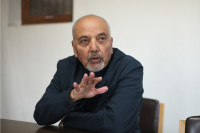Opinion
Writing on the wall
The clock is ticking for Nepal to take a decision on the remaining Bhutanese refugees
John Narayan Parajuli
The large-scale resettlement of Bhutanese refugees is coming to an end this year. Fewer than 10,000 of the 125,000 Bhutanese refugees are likely to be left behind in the camps in eastern Nepal. With the resettlement process coming to a close, there is a sense of uncertainty about the fate of the remaining refugees. What would happen to them? Will they remain in the camps or go back to Bhutan? Or will they be allowed to assimilate locally?
Under the principle of burden sharing, the international community has generously resettled over 100,000 Bhutanese refugees since 2007. By the end of this year, that number will reach 115,000. The international community expects Bhutan and Nepal to play their part in resolving this nearly three-decade-old refugee situation.
Among the remaining population, several thousands have clearly expressed their desire to go back to Bhutan. They have steadfastly refrained from declaring interest in third-country resettlement. Nepal has insisted that Bhutan take them back. Nepal’s position is right as a matter of principle. However, from a practical point of view, should the remaining refugees spend the rest of their lives in the camps?
There is no doubt that Bhutan is culpable and that, as our foreign ministry officials insist, Thimpu should at least take some refugees back. But who would play the role of the global police here? The international community—the US, the EU, Canada and Australia to be precise—has little leverage and is unwilling to spoil its strategic ties with New Delhi over Bhutanese refugees. And India has distanced itself from the issue. It seems clear that Thimpu is unlikely to take any refugees back. Even in case of a miracle, it will most likely take a token number of them back.
So once the resettlement option is exhausted and repatriation is ruled out, what remains on the table is local assimilation. Will Nepal continue to confine the refugees to the camps? If so, who will foot the bill for the continued humanitarian support? After 2019, no funds may be forthcoming. The World Food Programme has already begun food rationing as a result of reduced funding, while the UNHCR, UN’s refugee agency, has put together a three-year exit strategy to stop its operation in Bhutanese refugee camps by 2019.
What this means in practical terms is that a decision is being made for Nepal.
Local integration
The previous KP Sharma Oli government had shown some flexibility on the issue. “After pursuing the first two options, the remaining refugees will be given a local solution and they will not be allowed to remain stateless,” Bishnu Rimal, the chief political advisor to the then Prime Minister KP Sharma Oli quoted him. “The PM wants the long-running saga of Bhutanese refugees to come to an end.”
Oli had engaged Bhairaja Pandey, who has worked for the UNHCR in other countries, to recommend policy options on pursuing local solution. The core group of eight resettlement countries—the UK, US, Australia, Canada, Netherlands, Denmark, New Zealand and Norway—continues to hold regular consultations with the UNHCR and the government of Nepal. The key word emerging from these consultations seems to be “a path of self-sufficiency for the remaining refugees”.
Wittingly or not, Oli’s decision demonstrated a degree of maturity and compassion in dealing with the Bhutanese refugees—although the same cannot be said about his handling of the Madhes crisis.
It seems that Oli’s decision was not fully owned up by Nepal’s foreign policy establishment. Narayan Kaji Shrestha, senior Maoist leader and former deputy and foreign minister, rubbished claims of any change in Nepal’s policy on Bhutanese refugees formulated in the 1990s. In fact, a multi-million dollar proposal put together by the UN and the international community in 2011 to introduce a Community Based Development Programme (CBDP) and phase out the humanitarian support to promote greater self-reliance among the refugees was rejected by Shrestha when he was the foreign minister. The CBDP would also have benefitted locals residing in the vicinity of the refugee camps. But that ship has long sailed, along with the benefits that both the locals and the refugees would have received.
Shift in donor priority
To be clear, the international community is not advocating providing Nepali citizenship for the remaining refugees, not right away at least. What it is suggesting is that Nepal allow them to enjoy basic rights: right to education and work, and access to Nepal’s health care system, for example. Among those who will be left behind, many have strong family links in Nepal. So there is a case to be made on cultural and family grounds too.
While the Maoist leader Shrestha ruled out a policy decision on local assimilation, he did indicate that individual cases could be looked into on practical grounds. Obviously, there are geopolitical complications associated with a blanket policy on local assimilation. Regardless, a solution has to be found whether through a clear public announcement or through subtle changes. But before that, major parties should reach consensus on this issue, given the unfolding global scenario—so that when there is a government change, there is no flip-flopping on the issue. With 65 million people globally displaced, donors’ priority is rapidly changing.
Reaching a policy decision now will save Nepal the trouble of cobbling together a solution in 2019, which may incur much greater financial and political costs. An early decision would also allow Nepal to save face, rather than be seen as forced to address the vacuum left behind by UNHCR’s exit and absence of external funding.
With UNHCR’s three-year exit strategy coming into play from early next year, the clock is ticking for Nepal to take a decision.
Parajuli is an assistant editor at The Kathmandu Post




 7.12°C Kathmandu
7.12°C Kathmandu










